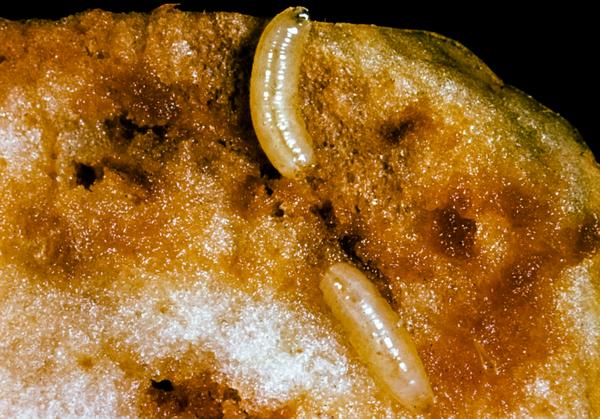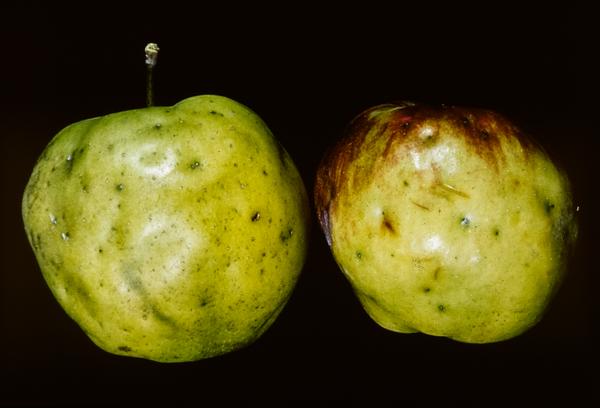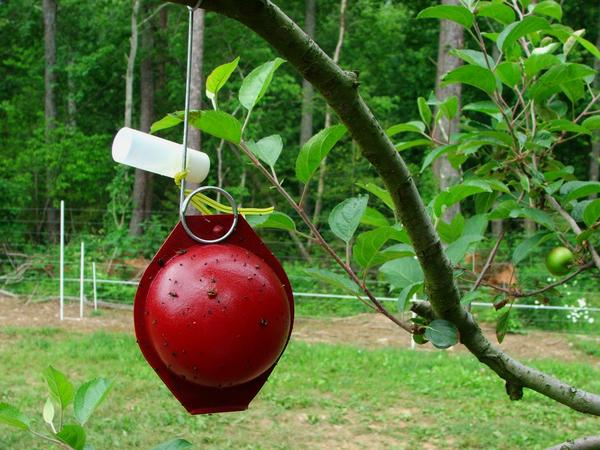Background and Description
The apple maggot (Rhagoletis pomonella) is a native fly of eastern North America that originally infested hawthorn trees. It became a considerable pest of apple in the Northeast, and although it is only a sporadic problem in the South, it can be highly destructive when it occurs in high numbers.
The adult fly is approximately 3/16 inch (5mm) long with a 1/3-inch (9mm) wingspan - slightly smaller than a housefly. Its body is black with white bands on the abdomen. Females have four bands and a somewhat pointed abdomen; males have three bands and a rounded abdomen. The clear wings have a distinct pattern of four black bands that mimic the appearance of a spider's legs, giving the fly some protection from predators. The pupa is 3/16 inch (4mm) long, brown, and oblong, and the larva is a 1/4-inch (6.5mm) long, white, legless maggot.
Life History
In western North Carolina, the apple maggot usually completes one generation per season at elevations above 2,000 feet (approximately 600 meters) and two generations below 1,200 feet (365 meters). Depending upon the year, fly activity can extend from June through September. Adult fly emergence from overwintering pupae in the soil is unpredictable and can occur from late May to August, but the peak emergence is usually between mid July and early August. About 7 days after emergence, flies become sexually mature and mate, after which females deposit eggs under the skin of apples by puncturing them with their ovipositor. After a few days a small maggot hatches from the egg, and the maggot tunnels within the fruit. When mature, the maggot exits the apple, drops to the ground, and burrows into the soil, where it completes development and forms a pupa. The pupa is the overwintering stage, and it emerges as a fly the following summer. If fly emergence is early in the season, some of their progeny emerge the same season rather than overwinter. In addition, a small percentage of flies may not emerge until 2 to 4 years later.
Weather conditions are important in dictating the timing and length of fly emergence. Pupae that are overwintering in lighter soils and in sunny areas emerge before those in heavier soils and shady areas. Sufficient soil moisture is also necessary for flies to emerge from soil-borne pupae. A drought will delay or prevent many flies from emerging. Also, abandoned orchards (or even a few nonsprayed trees) and wild hawthorn trees adjacent to apples are potential sources of flies, and are a threat to commercial orchards located within a distance of about 400 yards (365 meters).
Damage
Apple maggot larvae tunnel inside fruit. A decay organism associated with the maggot often causes the tunnels to become brown and enlarged, and in some varieties the apple can be reduced to a rotten mass. (Apple maggot larvae are sometimes called "railroad worms" because of these brown winding trails.) Although there is sometimes no sign of damage on the outside of the apple, other varieties may appear dimpled with numerous tiny egg punctures.
Monitoring and Control
Monitor apple maggot adults with red sticky spheres that are baited with a fruit essence lure. Baited spheres catch 2 to 4 times as many adults as non-baited spheres. In orchards with no history of maggot injury, a minimum of 3 red spheres should be placed on the outside row closest to the suspected source of flies (e.g., an abandoned orchard or woods). Hang spheres at eye level in trees with fruit, but remove fruit within 18 inches (50cm) of the sphere so that the sphere is highly visible to flies. In orchards with a history of damage, traps can also be placed in the interior on the southern side of trees. When using baited spheres, apply an insecticide after catching 5 flies cumulatively. Repeat an application at 14-day intervals if captures again reach 5 flies. Because the timing of emergence is difficult to predict, insecticide sprays should not be based on population trends of the previous year.
See the "Pest and Orchard Management Program" section of the Integrated Orchard Management Guide for Commercial Apples in the Southeast for the most current control guidelines.
Publication date: Feb. 23, 2015
N.C. Cooperative Extension prohibits discrimination and harassment regardless of age, color, disability, family and marital status, gender identity, national origin, political beliefs, race, religion, sex (including pregnancy), sexual orientation and veteran status.









